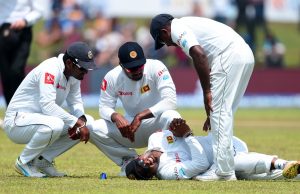Where there is sport, there are injuries. Every athlete has got some injuries through their sporting career. Injuries are a part and parcel of the game. Here is a short informative insight about injuries.
Sports injuries are injuries that occur during sport, athletic activities, or exercising. Sports injuries are commonly caused by overuse, direct blow, or the application of force that is greater than the body part can actually hold.
There are two kinds of sports injuries: acute and chronic. An injury that occurs suddenly, such as a twisting of the ankle caused by an awkward landing, is known as an acute injury. Chronic injuries are caused by repeated overuse of muscle groups or joints. Poor technique and structural abnormalities can also contribute to the development of chronic injuries.
Types of sport injury
Soft tissue injuries

Soft tissue injuries are the injuries that occur to the skin or the muscles or to any soft part of the body to simplify it more. They can be generally grouped into three categories: contusions, abrasions/ lacerations and tears. Contusions or bruises are a result from contact with an object. For example, a ball hitting the thigh which causes bluish discoloration of the skin. Severe contusions may involve deeper structures and can include an injury to the nerve
or blood vessels.
Abrasions are superficial injuries to the skin and bleeding, if present, are minimal. In simple terms, it is the damage to the skin when a person dives or falls to field a ball which sometimes can cause bleeding.
Hard tissue injuries

Types of hard tissue injuries can include dental and bone fractures and are less frequent than soft tissue injuries in sport, but are often more serious.
Overuse injuries

Overuse injuries can be defined as injuries that result from repetition of same kind of activities, without a specific onset incident. For example, stress reactions and fractures in the spine or shin bone.
Researchers say that Cricket injuries at elite level have been shown to occur at a rate of around 18 injuries in total for a squad of 25 players who play twenty matches in a season and that is a huge number. On average, around 9% of
cricketers have an injury at any given time, although in fast bowlers over 15% are injured at any given time.
There are very different physical demands involved in different types of cricket, which has meant the injury profile is slightly different between five-day Test matches and one-day matches. The launch of Twenty20 cricket has placed a
new physical requirement on cricketers, the game has gone faster and so the intensity on the field has also increased leading to increased number of injuries.
Research has indicated that muscle injuries such as hamstring strains and side strains are the most common cricket injuries. Low back pain is particularly prevalent among younger fast bowlers. The repetitive action of bowling for long spells places excessive stress on the tissues of the lower back, where stress fractures of the vertebra (spondylolysis or spondylolisthesis) can develop.
Most common types of cricket injuries:

Ankle sprain
Contusion/ Bruises
Concussion (ball hitting on the head/ helmet) – mild reversible brain injury
from a blow to the head, which may be associated with loss of consciousness.
Symptoms include headache, dizziness and short term memory loss.
Cuts and abrasions –The knees and hands are particularly prone.
Dehydration – losing too much fluid can lead to heat exhaustion and heat
stroke.
Dental damage – a blow to the jaw can crack, break or dislodge teeth.
Shoulder labrum and rotator cuff tear.
Groin strain
Hamstring/ Quadraceps strain bruising.
Knee joint injuries – The ligaments, tendons or cartilage can be affected.
Low back pain/ Stress fractures/ shin pain – particularly in the lower limbs.
The impact of repeated jumping or running on hard surfaces can eventually stress and crack bone. Here was the update on the different types of cricket injuries. In the coming articles I will be writing more on the cause of the injuries, how to prevent it and much more.
Stay tuned for more updates.
-By Physio Abishek Sawant



Comments are closed.